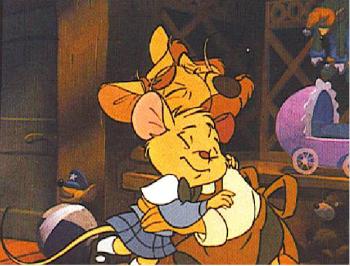Jim on Film
Page 6 of 6

(c) Disney
If The Great Mouse Detective was not original in using mice to tell its story, neither was Oliver & Company original in using cats and dogs to tell its story; however, it too sets out to be very different from anything the studio had done before in its story, characters, and tone.
Oliver & Company has an interesting art direction. The characters are designed appealingly and use rich colors, but the backgrounds return to the sketchy appearance of The Rescuers, though they are without that film’s vibrant colors and details. It’s also interesting that there are no cute characters among the four-footed cast, not even little Oliver is adorable.
There are also two re-uses of designs from Lady and the Tramp with two dogs who make quick appearances and look like Jock and Peg, but there is a Dalmatian who has no similarities with the dogs from One-Hundred-and-One Dalmatians.
As in the films before, the computer animated elements of Oliver & Company are another step forward for the studio. While there are a few things that are identifiably computer generated, they are well done and only a trained eye would be able to identify them. And there are some elements, such as Fagin’s tryke and Georgette’s stairs, that are simply done well.
Just as in The Great Mouse Detective, computers would be used to create a suspenseful and masterful climax, this time inside a subway. Before the computer, the studio had many thrilling climactic battles and chases, but with the computer, it allowed the filmmakers to conceive different kinds of scenes that heighten the sense of danger. And just as in the films from the Golden Age, starting with The Rescuers, the studio was making its return to the inclusion of thrilling dark elements. In Oliver & Company, the fast-paced chase through the subway is both violent and exciting as characters fall to their deaths or escape within an inch of their lives.
It’s surprising that Oliver & Company and The Great Mouse Detective haven’t been more memorable in the canon-particularly Oliver & Company, which was very successful in its first release. There are several reasons for this. First of all, in the past, such films always remained in the public’s eye, so people remembered them. Even though Alice in Wonderland wasn’t a big hit, there were attractions and characters at the parks with them, snippets on the weekly television series, continual merchandising, and so on. They were kept in the public’s memory. Plus, with these two films, and really The Black Cauldron too, the studio has unjustly abandoned them. That they were not as successful, either artistically or financially, as The Little Mermaid and the following films is not so much a commentary about the films themselves but the films that followed them. This is really too bad because these are very good movies and are something the studio should be proud of.
The Transitional Period is marked by a step away from the loose plotlines and use of humor and music of the Xerox Era, and though it is marked by the presence of two different core groups of artists, there is a progression from the comedies of the Xerox Era into drama and adventure.
Discuss It!
Related Links
-- Jim Miles
Jim On Film is normally published on the first Thursday of each month.
The opinions expressed by our guest columnists, and all of our columnists, do not necessarily represent the feelings of LaughingPlace.com or any of its employees or advertisers. All speculation and rumors about the future of Disneyland and the Walt Disney Company are just that - speculation and rumors - and should be treated as such.
-- Posted October 2, 2003
